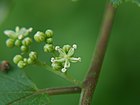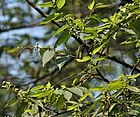Note: This is a project under development. The articles on this wiki are just being initiated and broadly incomplete. You can Help creating new pages.
Difference between revisions of "Trema orientalis"
(Created page with "{{stub}} ==Uses== {{Uses|}}, {{Uses|}}, {{Uses|}}, {{Uses|}}, {{Uses|}}, {{Uses|}}, {{Uses|}}, {{Uses|}}, {{Uses|}}, {{Uses|}}, {{Uses|}}.<ref name="Uses"/> ==Parts Used== {{...") |
|||
| Line 1: | Line 1: | ||
| − | + | [[File:Bel-phuar (in Mizo) (5496659166).jpg|thumb|right|''Trema orientalis'']] | |
| + | '''Trema orientalis''' is a fast-growing, evergreen shrub or tree with a heavy branching and rounded to spreading crown, reaching a height of up to 18 metres. It has a short basally swollen bole that can be 60cm in diameter. The plant has a wide range of traditional uses for food, medicine and other commodities. A fast-growing tree, it has several applications in agroforestry as a shade tree, pioneer species etc. | ||
==Uses== | ==Uses== | ||
| − | {{Uses|}}, {{Uses|}}, {{Uses|}}, {{Uses|}}, {{Uses|}}, {{Uses|}}, {{Uses| | + | {{Uses|Coughs}}, {{Uses|Sore throat}}, {{Uses|Asthma}}, {{Uses|Bronchitis}}, {{Uses|Gonorrhoea}}, {{Uses|Yellow fever}}, {{Uses|Toothache}}.<ref name="Uses"/> |
==Parts Used== | ==Parts Used== | ||
| − | {{Parts Used|}}, {{Parts Used| | + | {{Parts Used|Leaves}}, {{Parts Used|Fruits}}. |
==Chemical Composition== | ==Chemical Composition== | ||
| − | <ref name="chemical composition"/> | + | Compounds present in the plant include tannins, saponins, flavanoids, triterpenes, phytosterols, and several constituents of xanthones.<ref name="chemical composition"/> |
==Common names== | ==Common names== | ||
| − | {{Common names|sa=|en=|gu=|hi=|kn=|ks=|ml=|mr=|pa=|ta=|te=}} | + | {{Common names|sa=Jivani, Jivanti|en=Indian Charcoal Tree, Indian Nettle|gu=|hi=Gio, Jivan|kn=ಗೋರ್ಕು Gorku, ಕರುಹಾಲೆ Karuhaale|ks=|ml=Ratthi|mr=Ghol|pa=|ta=Yerralai|te=Kakamushti}}<ref name="Common names"/> |
==Properties== | ==Properties== | ||
| Line 16: | Line 17: | ||
===Dravya=== | ===Dravya=== | ||
===Rasa=== | ===Rasa=== | ||
| − | |||
===Guna=== | ===Guna=== | ||
| Line 29: | Line 29: | ||
==Habit== | ==Habit== | ||
| − | {{Habit|}} | + | {{Habit|Evergreen tree}} |
==Identification== | ==Identification== | ||
| Line 48: | Line 48: | ||
==Mode of Propagation== | ==Mode of Propagation== | ||
| − | {{Propagation|}} | + | {{Propagation|Seeds}}, {{Propagation|Cuttings}}. |
==How to plant/cultivate== | ==How to plant/cultivate== | ||
| − | <ref name="How to plant/cultivate"/> | + | Charcoal tree is a plant of the lowland humid tropics, where it can be found at elevations from sea level up to 2,500 metres.<ref name="How to plant/cultivate"/> |
==Commonly seen growing in areas== | ==Commonly seen growing in areas== | ||
| − | {{Commonly seen|}}, {{Commonly seen|}}, {{Commonly seen| | + | {{Commonly seen|Moist forests}}, {{Commonly seen|Dry scrub of open slopes}}, {{Commonly seen|Open places on hillsides}}. |
==Photo Gallery== | ==Photo Gallery== | ||
<gallery class="left" caption="" widths="140px" heights="140px"> | <gallery class="left" caption="" widths="140px" heights="140px"> | ||
| − | + | Bel-phuar (in Mizo) (5496659166).jpg | |
| + | Belphur (in Garo) (5496065937).jpg | ||
| + | Boggu-chettu (Telugu- బొగ్గు చెట్టు) (3998648602).jpg | ||
| + | Branches I IMG 3304.jpg | ||
| + | Flowers & leaves I IMG 3453.jpg | ||
| + | Trema orientalis (Pigeon Wood) W2 IMG 2236.jpg | ||
</gallery> | </gallery> | ||
| Line 64: | Line 69: | ||
<references> | <references> | ||
| − | <ref name="chemical composition">[" | + | <ref name="chemical composition">[https://www.ncbi.nlm.nih.gov/pmc/articles/PMC3731882/#:~:text=Medicinal%20plants%20are%20used%20by,studies%20on%20Trema%20orientalis%20Linn.&text=Compounds%20present%20in%20the%20plant,and%20several%20constituents%20of%20xanthones. Chemical constuents]</ref> |
| + | |||
| + | <ref name="Leaf">[Morphology]</ref> | ||
| − | <ref name=" | + | <ref name="Common names">[http://www.flowersofindia.net/catalog/slides/Indian%20Charcoal%20Tree.html Common names]</ref> |
| − | <ref name="How to plant/cultivate">[ | + | <ref name="How to plant/cultivate">[http://tropical.theferns.info/viewtropical.php?id=Trema+orientalis Cultivation]</ref> |
<ref name="Uses">Indian Medicinal Plants by C.P.Khare</ref> | <ref name="Uses">Indian Medicinal Plants by C.P.Khare</ref> | ||
</references> | </references> | ||
==External Links== | ==External Links== | ||
| − | * [ ] | + | * [https://www.ncbi.nlm.nih.gov/pmc/articles/PMC3731882/ Trema orientalis on Ncbi.nlm.nih.gov] |
| − | * [ ] | + | * [https://indiabiodiversity.org/species/show/31875 Trema orientalis on indiabiodiversity.org] |
| − | + | ||
[[Category:Herbs]] | [[Category:Herbs]] | ||
Latest revision as of 10:42, 26 August 2020
Trema orientalis is a fast-growing, evergreen shrub or tree with a heavy branching and rounded to spreading crown, reaching a height of up to 18 metres. It has a short basally swollen bole that can be 60cm in diameter. The plant has a wide range of traditional uses for food, medicine and other commodities. A fast-growing tree, it has several applications in agroforestry as a shade tree, pioneer species etc.
Contents
- 1 Uses
- 2 Parts Used
- 3 Chemical Composition
- 4 Common names
- 5 Properties
- 6 Habit
- 7 Identification
- 8 List of Ayurvedic medicine in which the herb is used
- 9 Where to get the saplings
- 10 Mode of Propagation
- 11 How to plant/cultivate
- 12 Commonly seen growing in areas
- 13 Photo Gallery
- 14 References
- 15 External Links
Uses
Coughs, Sore throat, Asthma, Bronchitis, Gonorrhoea, Yellow fever, Toothache.[1]
Parts Used
Chemical Composition
Compounds present in the plant include tannins, saponins, flavanoids, triterpenes, phytosterols, and several constituents of xanthones.[2]
Common names
| Language | Common name |
|---|---|
| Kannada | ಗೋರ್ಕು Gorku, ಕರುಹಾಲೆ Karuhaale |
| Hindi | Gio, Jivan |
| Malayalam | Ratthi |
| Tamil | Yerralai |
| Telugu | Kakamushti |
| Marathi | Ghol |
| Gujarathi | |
| Punjabi | |
| Kashmiri | |
| Sanskrit | Jivani, Jivanti |
| English | Indian Charcoal Tree, Indian Nettle |
Properties
Reference: Dravya - Substance, Rasa - Taste, Guna - Qualities, Veerya - Potency, Vipaka - Post-digesion effect, Karma - Pharmacological activity, Prabhava - Therepeutics.
Dravya
Rasa
Guna
Veerya
Vipaka
Karma
Prabhava
Habit
Identification
Leaf
| Kind | Shape | Feature |
|---|---|---|
Flower
| Type | Size | Color and composition | Stamen | More information |
|---|---|---|---|---|
| {{{5}}} |
Fruit
| Type | Size | Mass | Appearance | Seeds | More information |
|---|---|---|---|---|---|
Other features
List of Ayurvedic medicine in which the herb is used
Where to get the saplings
Mode of Propagation
How to plant/cultivate
Charcoal tree is a plant of the lowland humid tropics, where it can be found at elevations from sea level up to 2,500 metres.[5]
Commonly seen growing in areas
Moist forests, Dry scrub of open slopes, Open places on hillsides.
Photo Gallery
References
- ↑ Indian Medicinal Plants by C.P.Khare
- ↑ Chemical constuents
- ↑ Common names
- ↑ [Morphology]
- ↑ Cultivation
External Links
- Ayurvedic Herbs known to be helpful to treat Coughs
- Ayurvedic Herbs known to be helpful to treat Sore throat
- Ayurvedic Herbs known to be helpful to treat Asthma
- Ayurvedic Herbs known to be helpful to treat Bronchitis
- Ayurvedic Herbs known to be helpful to treat Gonorrhoea
- Ayurvedic Herbs known to be helpful to treat Yellow fever
- Ayurvedic Herbs known to be helpful to treat Toothache
- Herbs with Leaves used in medicine
- Herbs with Fruits used in medicine
- Herbs with common name in Kannada
- Herbs with common name in Hindi
- Herbs with common name in Malayalam
- Herbs with common name in Tamil
- Herbs with common name in Telugu
- Herbs with common name in Marathi
- Herbs with common name in Sanskrit
- Herbs with common name in English
- Habit - Evergreen tree
- Index of Plants which can be propagated by Seeds
- Index of Plants which can be propagated by Cuttings
- Herbs that are commonly seen in the region of Moist forests
- Herbs that are commonly seen in the region of Dry scrub of open slopes
- Herbs that are commonly seen in the region of Open places on hillsides
- Herbs






